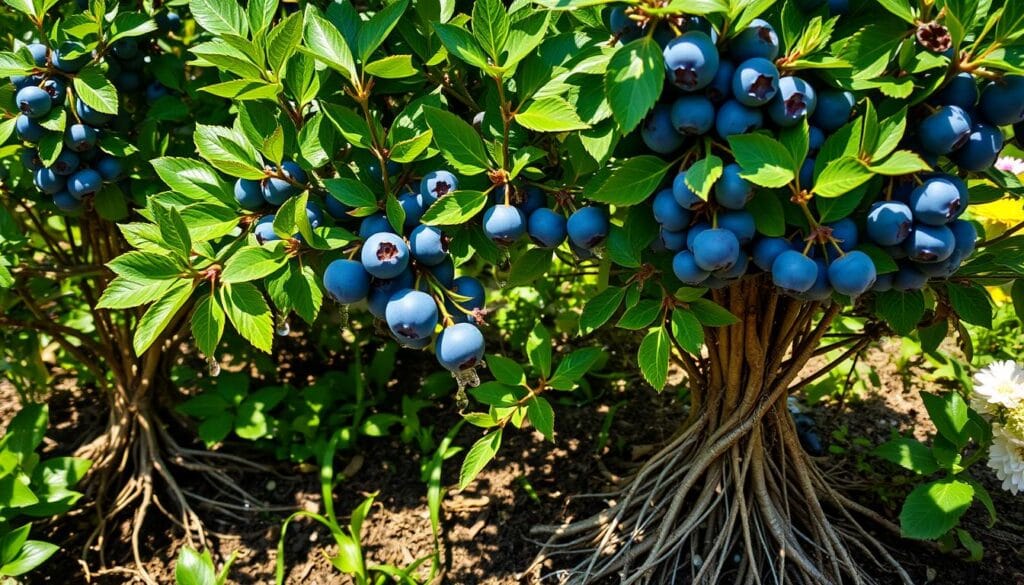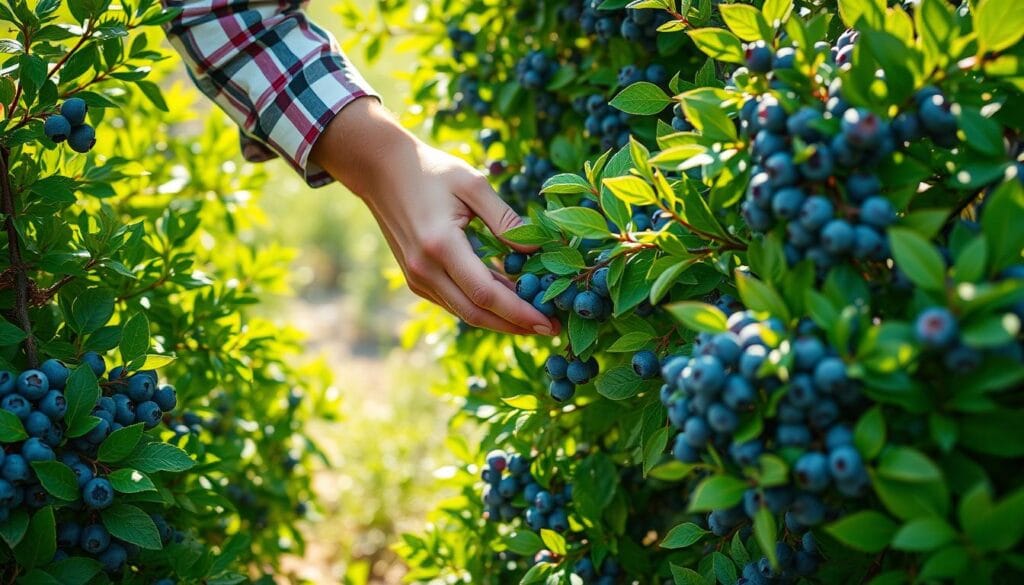Blueberries are a favorite fruit for many gardeners. They mix sweetness with tartness perfectly. This guide will help you grow blueberries successfully, whether you’re new or experienced. You’ll learn about different blueberry types, how to prune, and how to keep pests away.
Key Takeaways
- Discover the unique characteristics and growth patterns of various blueberry species, including highbush, rabbiteye, and lowbush varieties.
- Learn how to prepare your soil for optimal blueberry cultivation, including pH adjustments and nutrient management.
- Explore the best blueberry cultivars suited for home gardens, ensuring a successful and bountiful harvest.
- Understand the importance of proper watering, fertilization, and pruning techniques to maintain the health and productivity of your blueberry plants.
- Gain insights into effective pest and disease management strategies to protect your blueberry crop.
Understanding Blueberry Plants and Their Growth Requirements
Blueberry plants come in many species, each with its own growth pattern and needs. Knowing these differences is crucial for growing blueberries successfully.
Different Types of Blueberry Species
Home gardens often grow highbush, lowbush, and rabbiteye blueberries. Highbush varieties, like ‘Bluecrop’ and ‘Highbush’, have big, tasty berries and grow tall. Lowbush blueberries are smaller, more compact, and do well in cold climates. Rabbiteye blueberries, such as ‘Tifblue’ and ‘Climax’, are perfect for warmer areas and give lots of medium-sized fruit.
Basic Growth Patterns and Life Cycle
Blueberry plants start with dormant buds in winter. These buds bloom into white or pink flowers in spring. As it gets warmer, these flowers turn into juicy berries that ripen in summer. After picking, the plants focus on growing leaves and storing energy for next year.
Climate and Hardiness Zones
Blueberries vary in how well they handle cold and heat. It’s important to pick varieties that match your local climate and hardiness zone. For example, highbush blueberries do best in USDA Hardiness Zones 5-8. Rabbiteye blueberries prefer warmer Zones 7-9. Choosing the right climate ensures your blueberries grow well and give plenty of fruit every year.
Essential Soil Preparation for Blueberry Success
To grow thriving blueberry plants, start with the right soil. You need to focus on three main things: soil pH, organic matter, and drainage. Make sure your blueberry soil requirements are met.
Blueberries love acidic soil, best between 4.0 and 5.5 pH. If your soil is too alkaline, add sulfur or acidifying agents. The right pH helps plants absorb nutrients well.
- Test your soil’s pH levels with a simple at-home kit.
- Use sulfur or other acidifiers as needed to adjust pH.
Blueberry plants also need soil that drains well and is rich in nutrients. Add compost, peat moss, or other organic matter. This improves soil structure and fertility.
“Healthy soil is the foundation for a thriving blueberry patch. Taking the time to properly prepare your planting area will set your plants up for long-term success.”
Make sure your blueberry bed drains well to avoid waterlogging. This can cause root rot and other issues. Consider raised beds or adding sand or gravel to improve drainage if your soil is heavy or clay-based.
By following these steps, you’ll create the perfect soil for your blueberry plants. They will thrive and give you plenty of fruit for years.
Best Blueberry Varieties for Home Gardens
There are many blueberry varieties for home gardens. You can choose from highbush blueberry to lowbush blueberry. Each has its own special traits for your garden and taste. Let’s look at some top blueberry varieties for your backyard.
Highbush Blueberry Cultivars
Highbush blueberries are great for home gardens. They have bigger berries and grow strong. Some top highbush blueberry types are ‘Bluecrop’ and ‘Duke’. ‘Bluecrop’ gives consistent yields and great taste. ‘Duke’ has early-ripening fruit that’s tangy-sweet.
‘Elliot’ is also a good choice. It has a long harvest season and is very cold hardy.
Rabbiteye Blueberry Options
Rabbiteye blueberries are perfect for warmer climates. They grow well in zones 7-9. They have bigger berries and a longer harvest time. ‘Tifblue’ and ‘Climax’ are popular for their sweet flavor and early fruit.
Lowbush Blueberry Types
Lowbush blueberries are great for small spaces. They grow low to the ground and have small but tasty berries. ‘Brunswick’ and ‘Northland’ are reliable choices for a small garden.

Choosing the right blueberry variety depends on several factors. Consider fruit size, taste, disease resistance, and your local climate. By exploring different blueberry varieties, you can find the perfect one for your garden. This will make your blueberry harvest both delicious and abundant.
Optimal Planting Techniques and Timing
Getting the planting right is key for growing blueberries. The right techniques and timing help your plants grow strong and healthy in your garden.
First, pick the best time to plant in your area. Blueberries do well in early spring, from March to May. This lets them grow strong before summer gets hot. It also gives them time to build a good root system before winter.
For planting, space blueberry bushes 4-6 feet apart. Dig a hole twice as wide and deep as the root ball. Fill it with acidic soil and compost, but don’t pack the soil too hard. Proper spacing and depth are key for your plants’ health and growth.
If you need to move a blueberry plant, do it in late fall or early spring. Dig carefully to keep as much root as you can. Then, replant it using the same steps as before.

“Establishing a thriving blueberry patch takes a bit of planning and preparation, but the rewards are well worth the effort.”
By using these planting tips, you’ll get a great blueberry harvest soon.
| Planting Technique | Recommendation |
|---|---|
| Planting Time | Early spring (March-May) |
| Plant Spacing | 4-6 feet apart |
| Planting Hole Size | Twice the width of the root ball, same depth |
| Soil Preparation | Well-draining, acidic soil mixed with compost |
| Transplanting | During dormant season (late fall or early spring) |
Watering Requirements and Irrigation Methods
Proper watering is key for blueberry plants to grow well. They need the right amount of water to produce lots of fruit. Knowing how to water them correctly is important for their health.
Drip Irrigation Systems
Drip irrigation is a great way to water blueberries. It sends water straight to the roots, saving water and helping roots grow deep. These systems are easy to set up and can be programmed to water just right.
Moisture Monitoring Tips
- Check the soil moisture often to keep it just right.
- Use a soil moisture meter to see if you need to water more.
- Watch for signs of wilting in the leaves to know when to water.
Water Quality Considerations
The water quality is also important for blueberries. They like acidic soil and water with a pH between 4.0 and 5.5. If your water is too alkaline, use a water acidifier or special soil mix.
| Water Quality Parameter | Optimal Range for Blueberries |
|---|---|
| pH | 4.0 to 5.5 |
| Dissolved Salts | Less than 500 ppm |
| Hardness | Less than 100 ppm |
By understanding how to water and using the right methods, you can help your blueberries grow well. They will get the water and quality they need to thrive and give you lots of fruit.

Fertilizing Your Blueberry Plants
Proper blueberry fertilization is key for your plants’ health and fruit. You can choose organic or synthetic fertilizers. Knowing what blueberries need will help you get a great harvest.
Blueberries love acidic soil, with a pH of 4.0 to 5.5. Use an organic fertilizer with sulfur or ammonium sulfate. These help lower the pH and give your plants the nutrients they need.
- Start with a balanced, slow-release fertilizer in early spring when leaves start to grow.
- Don’t over-fertilize, as it can cause too much growth and less fruit.
- Use a foliar spray of micronutrients like iron and boron to fix specific issues.
| Nutrient | Importance for Blueberries | Recommended Application Rate |
|---|---|---|
| Nitrogen (N) | Promotes healthy foliage and plant growth | 1-2 lbs of actual N per 100 sq ft |
| Phosphorus (P) | Supports root development and fruit production | 1-2 lbs of actual P per 100 sq ft |
| Potassium (K) | Enhances winter hardiness and disease resistance | 2-3 lbs of actual K per 100 sq ft |
By following these blueberry fertilization tips, your plants will get the nutrients they need. The secret is finding the right balance and not over-fertilizing.

“Feeding your blueberry plants the right nutrients at the right time is the foundation for a bountiful harvest.”
Pruning and Maintenance Guidelines
Proper blueberry pruning is key to keeping your plants healthy and productive. By sticking to an annual pruning schedule and using the right tools, your blueberries will thrive. This ensures they grow well year after year.
Annual Pruning Schedule
The best time to prune blueberries is in late winter or early spring. This is before new growth starts. It helps the plants focus on growing strong canes and leaves. Prune your blueberries every year to remove dead, damaged, or crowded stems.
Tools and Techniques
- Use sharp, clean pruning shears or loppers for clean cuts, avoiding damage.
- Prune at a 45-degree angle, about 1/4 inch above an outward-facing bud or branch.
- Remove canes older than 6 years, as they produce less fruit.
- Thin the plant’s center for better air and sunlight.
Rejuvenation Pruning
If your blueberries are overgrown or not producing much, try rejuvenation pruning. Cut the plant back to the ground, leaving a few young, healthy canes. This might seem scary, but it can really help your plants.
| Pruning Tool | Recommended Use |
|---|---|
| Pruning Shears | Cutting stems up to 1/2 inch in diameter |
| Loppers | Cutting stems up to 1 inch in diameter |
| Pruning Saw | Cutting larger, thicker stems |
By following these blueberry pruning tips, your plants will stay healthy, productive, and look great for years.

Common Pests and Disease Management
Keeping your blueberry plants healthy is key for a great harvest. Blueberry pests and diseases can harm your plants. It’s important to act fast to protect your blueberry paradise.
The blueberry aphid is a common pest that can weaken your plants. Use natural predators like ladybugs or organic insecticidal soaps to fight them. The blueberry maggot can also damage your berries. Monitor your plants closely and treat them as needed to control this pest.
Fungal diseases like mummy berry and anthracnose can harm your blueberries too. Preventive steps like pruning and good soil drainage can help. Organic fungicides can also protect your plants from these diseases.
| Common Blueberry Pests | Common Blueberry Diseases |
|---|---|
| Blueberry Aphid | Mummy Berry |
| Blueberry Maggot | Anthracnose |
| Spotted Wing Drosophila | Powdery Mildew |
| Japanese Beetle | Phytophthora Root Rot |
By being proactive and using a comprehensive pest management plan, you can protect your blueberries. This will keep your plants healthy and productive for many years.
“The key to successful blueberry cultivation is maintaining a proactive approach to pest and disease management. With the right techniques, you can keep your plants thriving and your harvest bountiful.”
Prevention is the best way to protect your blueberries. Regular checks, quick action on problems, and using eco-friendly methods can help. This will keep your blueberry bushes healthy and strong.
Harvesting and Storage Methods
Learning how to harvest blueberries is key to enjoying your hard work. Knowing when they’re ripe and how to pick them right helps keep them fresh longer. This way, you can enjoy your blueberries at their best.
The best time to pick blueberries is when they’re a deep blue color and come off the stem easily. Don’t pick too many, as it can hurt the plant and lower next year’s crop. It’s best to pick them by hand to avoid bruising.
- Pick blueberries in the morning when they’re cool and firm. The afternoon sun can make them soft and spoil faster.
- Put the picked blueberries in shallow containers to avoid squishing them.
- Keep them in the fridge at 32-40°F to stay fresh for up to two weeks.
To keep blueberries longer, freeze them. Rinse, dry, and lay them out on a baking sheet. Once frozen, put them in an airtight container or bag. Frozen blueberries stay good for up to a year, keeping their taste and nutrients.
| Harvesting Technique | Ripeness Indicator | Storage Condition | Shelf Life |
|---|---|---|---|
| Gentle hand-picking | Deep blue color, easy stem detachment | Refrigerator (32-40°F) | Up to 2 weeks |
| Freezing | N/A | Freezer | Up to 1 year |
By using the right blueberry harvesting and storage methods, you can keep your blueberries fresh and tasty for a long time. Enjoy them for weeks or even months.
“The key to successful blueberry harvesting is patience and attention to detail. Properly timing the pick and handling the berries with care can make all the difference in the quality of your crop.”
Winter Care and Protection Strategies
As winter gets closer, it’s key to protect your blueberry plants. Good winter care keeps them safe from harsh weather. This way, you’ll have a great harvest next year.
Mulching Techniques
Putting a thick layer of organic mulch around your blueberry plants is vital. It keeps the roots warm and moist. Use wood chips, pine needles, or shredded bark, and keep it 4-6 inches thick.
Frost Protection Methods
Blueberry plants don’t like frost, and sudden cold can harm them. To protect them, use row covers or plant blankets. These keep warm air in and frost out, saving your plants.





